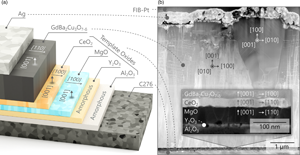 ${\rm RB}{\rm a}_ 2{\rm C}{\rm u}_ 3{\rm O}_{ 7-{\rm \delta }}$ (R = Gd, Sm) High-Temperature Superconducting Coated Conductors
${\rm RB}{\rm a}_ 2{\rm C}{\rm u}_ 3{\rm O}_{ 7-{\rm \delta }}$ (R = Gd, Sm) High-Temperature Superconducting Coated ConductorsPublished online by Cambridge University Press: 01 October 2021

In the field of high-temperature superconductors, atom probe tomography is a relatively new instrument, with the ability to provide a new perspective on the 3D nanoscale microstructure. However, field evaporation of nonmetallic materials is fraught with unique challenges that matter little in the world of metallic evaporation. In this study, we review the laser absorption, correlated evaporation, molecular dissociation, and the crystallographic effects on the field evaporation of 800-m  ${\rm RB}{\rm a}_ 2{\rm C}{\rm u}_ 3{\rm O}_{ 7-{\rm \delta }}$ (R = Gd, Sm) coated conductor tapes deposited by Reactive Co-Evaporation Cyclic Deposition and Reaction (RCE-CDR). Ultraviolet 355 nm laser pulsing was found to have a substantial beneficial effect on minimizing the fracture probability compared with 532 nm illumination, especially when evaporating insulating oxide precipitates. This, in turn, allows for the 3D compositional analysis of defects such as flux pinning centers introduced by precipitation and doping. As a result, evidence for the precipitation of nanoscale
${\rm RB}{\rm a}_ 2{\rm C}{\rm u}_ 3{\rm O}_{ 7-{\rm \delta }}$ (R = Gd, Sm) coated conductor tapes deposited by Reactive Co-Evaporation Cyclic Deposition and Reaction (RCE-CDR). Ultraviolet 355 nm laser pulsing was found to have a substantial beneficial effect on minimizing the fracture probability compared with 532 nm illumination, especially when evaporating insulating oxide precipitates. This, in turn, allows for the 3D compositional analysis of defects such as flux pinning centers introduced by precipitation and doping. As a result, evidence for the precipitation of nanoscale  ${\rm G}{\rm d}_ 2{\rm C}{\rm u}_ 2{\rm O}_ 5$ is discussed. The effect of crystallographic orientation is studied, where [001] aligned evaporation is found to develop compositional aberrations.
${\rm G}{\rm d}_ 2{\rm C}{\rm u}_ 2{\rm O}_ 5$ is discussed. The effect of crystallographic orientation is studied, where [001] aligned evaporation is found to develop compositional aberrations.